Which Way Home
From Wikipedia, the free encyclopedia
| Which Way Home | |
|---|---|
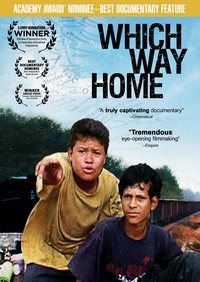 | |
| Directed by | Rebecca Cammisa |
| Produced by | Rebecca Cammisa |
| Music by | James Lavino |
| Cinematography |
|
| Edited by |
|
Production
company | |
| Distributed by | HBO Films |
Release dates
|
|
Running time
| 90 minutes |
| Country | United States |
| Language |
|
Which Way Home is a 2009 documentary film directed by Rebecca Cammisa. The film follows several children who are attempting to get from Mexico andCentral America to the United States, on top of a freight train that crossesMexico known as "La Bestia" (The Beast). Cammisa received a Fulbright Scholar Grant to make the documentary in 2006. The film premiered on HBOon August 24, 2009.
Sypnosis[edit]
Each year, thousands of Latin American migrants travel hundreds of miles to the United States, with many making their way on the tops of freight trains. Roughly five percent of those traveling alone are children. As the United States continues to debate immigration reform, the documentary Which Way Home looks the issue through the eyes of children who face the harrowing journey with enormous courage and resourcefulness.
Characters[edit]
- Kevin: A fourteen-year-old boy trying to reach America to be able to support his mother back in Honduras. Eventually, Quickly finds out that life there is equally difficult in different ways.
- Fito: A thirteen year old boy trying to find work in America. He leaves his hometown in Honduras with Kevin, also hoping to find a better life away from his grandmother and absent mother.
- Yurico: A seventeen year old boy, who leaves Chiapas, Mexico in hopes of finding a family that will adopt him in the US. Having no family, he lives on the streets begging in Chiapas and strikes up a close friendship with Fito on the journey to the border. He struggles with an addiction to huffing glue.
SYNOPSIS
As the United States continues to build a wall between itself and Mexico, Which Way Home shows the personal side of immigration through the eyes of children who face harrowing dangers with enormous courage and resourcefulness as they endeavor to make it to the United States.The film follows several unaccompanied child migrants as they journey through Mexico en route to the U.S. on a freight train they call "The Beast." Director Rebecca Cammisa(Sister Helen) tracks the stories of children like Olga and Freddy, nine-year-old Hondurans who are desperately trying to reach their families in Minnesota, and Jose, a ten-year-old El Salvadoran who has been abandoned by smugglers and ends up alone in a Mexican detention center, and focuses on Kevin, a canny, streetwise 14-year-old Honduran, whose mother hopes that he will reach New York City and send money back to his family. These are stories of hope and courage, disappointment and sorrow.They are the ones you never hear about – the invisible ones.MEET THE CHILDREN
Kevin, a canny, 14-year-old Honduran, who is traveling through Mexico to get to the United States. His reason: to find a job and send money back to his mother, Lupe. Kevin hopes to buy her a house so that she can leave an abusive relationship. Lupe hopes he will find work, or some U.S. citizen will adopt him. Kevin wants to go to Manhattan. But the trip he takes is a revelation to Kevin – he was prepared for the harshness of the journey, but the violence that he experiences and witnesses takes its toll. Unexpectedly, he reexamines the high cost migrants pay for their common dream of a better life in the United States.Fito, 13-year-old Honduran whose mother abandoned him when he was very young, lives with his impoverished grandmother, who has a job making cigars. He is traveling to the U.S. to look for work and hopes to be adopted.Yurico, a 17-year-old Mexican who ran away from his mother, has lived on the streets of Tapachula, Chiapas since age seven. Yurico proclaims that his life has been spent begging and sleeping on streets, thieving and abusing drugs; sometimes he makes money by washing buses at the city depot. Yurico wants a life free of drugs and violence, and is traveling to the U.S. to find a loving family.Jairo, a 14-year-old Mexican whose father never accepted him. He has lived on the streets of Chiapas since his mother was killed a year ago. Schooling is very important to him, but he cannot currently afford to continue his education. Jairo has decided to go to Laredo, Texas to find employment, and then return to Mexico with money to hire a tutor.Jose, a nine-year-old Salvadoran, lives with his aunt, and has not seen his mother Rosa since she left to work in the U.S. three years ago. Hoping to live with her, he traveled through Mexico on a bus with a smuggler. When Mexican immigration officials boarded the bus, the smuggler abandoned Jose, who was then taken to a detention center.Olga and Freddy, nine-year-old Hondurans being taken to the U.S. by smugglers, travel on Mexican freight trains. Olga is trying to get to her mother and sisters in Minnesota, while Freddy wants to reunite with his father. Both have witnessed many accidents while riding the trains, and hope that God will bless their journey.Juan Carlos, a 13-year-old Guatemalan, left a letter for his mother Esmeralda, stating that he was going to the U.S. to help her and his siblings. Juan Carlos' father abandoned the family years ago, so he feels it is his responsibility to provide for them. He also wants to find his father in New York, and confront him about why he's forgotten them.WHICH WAY HOME also features the families of two young migrants who did not survive their journey. The bodies of 13-year-old Eloy and his 16-year-old cousin Rosario were found separately in the desert. Their deaths, along with the other stories of those featured in the film, underscore the extremely dangerous journey undertaken by these often-invisible children, who are making adult decisions to change their lives.ABOUT THE FILMMAKERS
Rebecca Cammisa
Director/Producer
In 2003, Rebecca Cammisa founded Documentress Films, teamed up with Mr. Mudd Productions, and began developing the 2010 OSCAR®-nominated documentary, “Which Way Home,” for which she received a 2006 Fulbright Fellowship for Filmmaking.“Which Way Home” aired on HBO and was nominated for a 2010 Independent Spirit Award for Best Documentary, and received four EMMY nominations. The film won the 2010 News & Documentary Emmy Award for Outstanding Informational Programming and also received a 2010 Imagen Award for Best Documentary on Television.Ms. Cammisa co-directed, co-produced, and shot the feature documentary film, "Sister Helen," which aired on HBO, and won the Sundance Film Festival's 2002 Documentary Directing Award, was nominated for both a 2004 EMMY Award for Outstanding Cultural and Artistic Programming, and an Outstanding Directorial Achievement in Documentary Film Award by the Directors Guild of America. Rebecca has worked on various films and television series for IFC, A&E Films, and the History Channel.In 2010, Rebecca was honored with a John Simon Guggenheim Fellowship for Filmmaking, and the Robert F. Kennedy Journalism Awards Grand Prize. In 2012, Rebecca directed and produced the OSCAR®-nominated documentary short, "God is the Bigger Elvis."
REVIEWS
"Tremendous - eye opening filmmaking."
Erik Price, Esquire
"Tackles the almost unfathomably complex immigration issue by zooming in on some of its youngest victims."
David Hinckley, The New York Daily News
"Taps into the same concept and themes of Sin Nombre, except it's all real and it's all heartbreaking to watch...A truly captivating documentary, that doesn't carry an agenda...it brings you to the front lines of a war we know very little about and turns the audience member into an expert. But, like with most documentaries, what becomes of that new chunk of brutal information is entirely up to you. My advice: Turn to the person next to you and tell them there's a great film they need to see."
Erik Davis, Cinematical
"An unflinching look at the world of Central American child migrants."
The Wall Street Journal
"Dramatically and pictorially pulls its weight...a reverse-angle on the many documentaries about decamped mothers or fathers who toil in New York or Los Angeles to send cash back to families from whom they are exiled."
Ronnie Scheib, Variety
"Despite the subject matter -- terrified children, many who haven't seen their families in years -- Cammisa never gets sentimental, and instead lets those closest to the subject do the talking."
New York Magazine
"Without resorting to any background narration, Which Way Home raises questions about cross-border immigration policies and the macro-economic causes that propel people from struggling countries to stream into developed ones."
Reed Johnson, Los Angeles Times
"Some of them make it. Some of them don't. But all of them remind us what it truly means to be brave and literally chase after your dreams."
Latina Magazine
"Exceptionally effective filmmaking."
Jennifer Merin, About.com
"What comes out of the film is a message of hope, as there needs to be a serious discussion about immigration policy by both sides of the border. Having a situation where so many children are risking their lives to try and come here is pretty unacceptable. Thankfully, Which Way Home is a film that informs and inspires - as the first step in creating real change is to give people the knowledge of what is actually happening - and that is an incredibly hopeful thing."
Gina Telaroli, TakePart.com
"Produces a powerful testimony of how absolute poverty hurls even young children into the clandestine migrant stream. It is the best film made of the undocumented migration of Central Americans into the United States."
Nestor Rodriguez, Professor, Department of Sociology, The University of Texas at Austin, Author, When States Kill: Latin America, the U.S., and Technologies of Terror
"It's an amazing film. As someone who teaches immigration courses but also does research precisely on the issue of family separation and the migration of children, I have seen many films about how migrants reach the United States. But I've never seen anything like Which Way Home. It's easily the best documentary of its kind I've seen... The film does not dehumanize or essentialize these children. Rather, the humane and sensitive lens seems to aim to present a realistic picture that can inform many about the human drama that these young immigrants and their families live...But we don't only get to hear the children's stories in their own voices, we also learn their parents' views, and get a good glimpse of the context within which the kids live and within which they make decisions to migrate...A remarkably well done documentary that will inform many students of immigration and spark important debates."
Cecilia Menjivar, Professor of Sociology, School of Social and Family Dynamics, Arizona State University, Author, Fragmented Ties: Salvadoran Immigrant Networks in America
"Heartbreaking... These stories illustrate how U.S. immigration and border enforcement policies affect families thousands of miles away who have no recourse but to migrate without documents so as to find opportunities for work. This documentary is an invaluable educational tool for all ages."
Patricia Zavella, Professor and Chair, Latin American and Latino Studies, University of California-Santa Cruz, Author, Women and Migration in the US-Mexico Borderlands
FILM FESTIVALS
U.S. Film Festivals
- Cine Las Americas Film Festival, Texas
- Columbus International Film & Video Festival, Ohio
- Los Angeles Film Festival, California
- New York International Latino Film Festival
- Napa Sonoma Wine Country Film Festival
- North Carolina Latin American Film Festival
- Rocky Mountain Women’s Film Festival, Denver
- San Francisco Immigrant Film Festival, California
- Sedona Film Festival, Arizona
- Traverse City Film Festival, Michigan
- Tribeca Film Festival, New York (World Festival Premiere)
- United Nations Association Film Festival
International Film Festivals
- Ambulante Film Festival, Xalapa, Veracruz, Mexico
- Bermuda Docs International Film Festival
- Ciclo de Cine Documental, Bilwi, Nicaragua
- CineMigrante Film Festival, Buenos Aires, Argentina
- CineMigrante Film Festival, Bogota, Colombia
- CNEX Documentary Film Festival, Taipei, Taiwan
- Documenta Madrid, Spain
- Docaviv, Tel Aviv, Israel
- Festival de Films sur les Droits de la Personne de Montréal, Canada
- Global Visions Film Festival, Edmonton, Canada
- Havana International Film Festival, Cuba
- Hot Docs Film Festival, Toronto, Canada
- Human Rights Film Festival, Sarajevo, Bosnia & Herzegovina
- IDFA, Holland
- International Film Festival & Forum on Human Rights, Geneva, Switzerland
- International Human Rights Film Festival, Mexico City
- Istanbul International Meeting of Cinema & History Film Festival, Turkey
- Karlovy Vary Film Festival, Czech Republic
- Kiev International Film Festival, Ukraine
- Latin American Film Festival, Utrecht, Holland
- Latin Beat Film Festival, Japan
- Marda Loop Justice Film Festival, Calgary, Canada
- Montreal Human Rights Film Festival, Canada
- Morelia International Film Festival, Mexico
- One World International Film Festival, Prague, Czech Republic
- Open Doek Film Festival, Belgium
- 1000 Metros Bajo Tierra Film Fest, Merida, Venezuela
- Refuge in Films, London, U.K.
- Reykyavik International Film Festival, Iceland
- San Sebastian Human Rights Film Fest, Spain
- Seoul International Youth Film Festival, South Korea
- Thessaloniki Documentary Film Festival, Greece
- 20th Africa, Asian & Latin American Film Fest, Milano, Italy
- UNICEF ‘s Convention on Rights of the Child Film Festival, Amman, Jordan
- WATCH DOCS/Human Rights in Film, Poland
- Zacatecas Film Festival, Mexico
- Week of New Minorities, Slovakia
THE MAKING OF THE FILM
 How did you meet your interview subjects?
How did you meet your interview subjects?We met our subjects in many different ways’ mostly in immigration detention centers, by the railroad tracks, and other locations where migrants converged to travel north. We felt it was extremely important to find families of children who had died migrating in the Sonora Desert, to make two points: that children are in grave danger when they migrate through Mexico, and that this practice is an urgent child welfare issue.
What aspect of the children’s journey surprised/shocked you most? Were you surprised by their age, conditions, and circumstances?
After researching this story for so long, I was not surprised or shocked by the circumstances of child migrants’ lives. However, I was taken by their utter commitment to pursing their dreams of reaching the United States. I did hold my breath when watching our young subjects hopping the trains. Sometimes, they treated the train like a playground; jumping from boxcar to boxcar, jumping off the train to run alongside it, only to jump back on again – just for laughs. They really did not have a “healthy fear” of freight trains as a dangerous means of travel.
After researching this story for so long, I was not surprised or shocked by the circumstances of child migrants’ lives. However, I was taken by their utter commitment to pursing their dreams of reaching the United States. I did hold my breath when watching our young subjects hopping the trains. Sometimes, they treated the train like a playground; jumping from boxcar to boxcar, jumping off the train to run alongside it, only to jump back on again – just for laughs. They really did not have a “healthy fear” of freight trains as a dangerous means of travel.
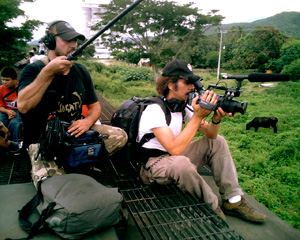 What kind of impact did your presence have on the journey?
What kind of impact did your presence have on the journey?We wanted our impact to be minimal. As observers, our job was to document their lives while traveling with them. However, since our subjects were children, we made it a point to remind them how dangerous the road ahead could be, and we offered to help connect them with migration officials if they wanted to go home.
The realm we were filming in was full of smugglers, gang members, and corrupt officials. As a crew, we were always mindful of how our child subjects could potentially be put in danger by the presence of our cameras and ourselves. On several occasions, we decided not to travel with children when threats towards us were made.
How long was the filming? Were there gaps in between shoots? How did you track your subjects?
This film took six years to complete, and there where many gaps in between shoots. I first pitched this film idea in early 2003, and received a development grant from the Sundance Documentary Fund. In November 2004, I traveled to Mexico to research, scout locations, film child subjects, and edit a trailer for fundraising purposes. While filming in 2004, I was struck by the huge multitudes of migrants that had crossed over from Guatemala into Tapachula, Mexico, and were waiting on the tracks to hop freight trains going north. This fact made it very easy for us to meet potential subjects. Unfortunately, the development money ran out and I was forced to return to Mexico City and cut a trailer with the footage I had.
This film took six years to complete, and there where many gaps in between shoots. I first pitched this film idea in early 2003, and received a development grant from the Sundance Documentary Fund. In November 2004, I traveled to Mexico to research, scout locations, film child subjects, and edit a trailer for fundraising purposes. While filming in 2004, I was struck by the huge multitudes of migrants that had crossed over from Guatemala into Tapachula, Mexico, and were waiting on the tracks to hop freight trains going north. This fact made it very easy for us to meet potential subjects. Unfortunately, the development money ran out and I was forced to return to Mexico City and cut a trailer with the footage I had.
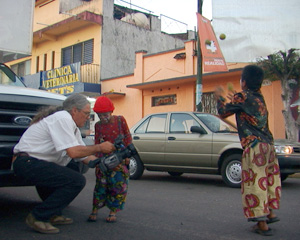 Shortly after HBO came on board, I decided to search for an executive producer. That same year, Lianne Halfon, Russell Smith and John Malkovich of Mr. Mudd stepped in. Fortunately for us, Mr. Mudd agreed to executive produce, and while they worked tirelessly to find investors, filming was halted for a year and a half. Because of Mr. Mudd’s involvement, I was able to return to Mexico to complete principal filming. In 2006, investors were found, and I also received a Fulbright Fellowship to Mexico for Filmmaking. This 11-and-a-half-month fellowship began in the fall of 2006, and helped me greatly by providing: 1) a stipend that covered my living expenses, and 2) the most important factor – a work visa, which granted me the extended time in Mexico to complete filming.
Shortly after HBO came on board, I decided to search for an executive producer. That same year, Lianne Halfon, Russell Smith and John Malkovich of Mr. Mudd stepped in. Fortunately for us, Mr. Mudd agreed to executive produce, and while they worked tirelessly to find investors, filming was halted for a year and a half. Because of Mr. Mudd’s involvement, I was able to return to Mexico to complete principal filming. In 2006, investors were found, and I also received a Fulbright Fellowship to Mexico for Filmmaking. This 11-and-a-half-month fellowship began in the fall of 2006, and helped me greatly by providing: 1) a stipend that covered my living expenses, and 2) the most important factor – a work visa, which granted me the extended time in Mexico to complete filming.
Because there were many delays in filming, most of the time we would be forced to begin again with new child subjects. Also, after Hurricane Stan struck in 2005, the landscape in Tapachula, Mexico irrevocably changed. This hurricane destroyed infrastructure, train tracks, and wiped out the train bridge that trains took north. Therefore the trains stopped running and migrants were forced to find other dangerous routes to cross. Partial funding arrived in January 2007, but by the time we returned to film, it was much harder to connect with potential subjects. Our shooting schedule lasted three weeks when bureaucratic and contractual delays forced myself, and my crew to suspend filming and leave the field again.
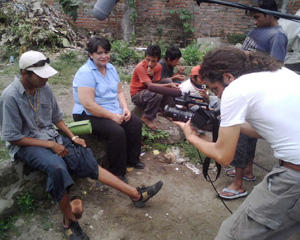 Six months later, in July 2007, filming continued, and we had to find new child subjects. Also, the train company that operated in southern Mexico officially folded. We did not realize it at the time, but the train we took with our new child subjects was the last one that went north. Filming halted once again for three weeks, but we were able to follow up with our child subjects in mid-August through September, and again in November 2007.
Six months later, in July 2007, filming continued, and we had to find new child subjects. Also, the train company that operated in southern Mexico officially folded. We did not realize it at the time, but the train we took with our new child subjects was the last one that went north. Filming halted once again for three weeks, but we were able to follow up with our child subjects in mid-August through September, and again in November 2007.
Your crew has incredible access within the governmental agencies in Mexico. How were you able to get clearance?
Gaining access and permissions from governmental officials and various agencies took many months to obtain. I was very fortunate in meeting Alejandra Liceaga, the film’s production manager. She was instrumental in making those initial contacts, building support, and pursuing the permissions until we finally received them.
Gaining access and permissions from governmental officials and various agencies took many months to obtain. I was very fortunate in meeting Alejandra Liceaga, the film’s production manager. She was instrumental in making those initial contacts, building support, and pursuing the permissions until we finally received them.
I must say that we received lots of support and good will from Central American and Mexican officials, who really believed in the story we were trying to tell, and so the accesses were granted.
What is your intended impact for the film?
To make the public aware of the realities of child migration, and to provide a greater understanding of not only how but also why children are so driven to make this journey alone. Many child migrants are trying to find relatives, so one challenge is how to provide laws that migrating children and their parents can be reunified safely. Lastly, and very hopefully, that this film will serve as a catalyst to promote a dialogue that leads to creating humane, immigration policy reform in the United States.
To make the public aware of the realities of child migration, and to provide a greater understanding of not only how but also why children are so driven to make this journey alone. Many child migrants are trying to find relatives, so one challenge is how to provide laws that migrating children and their parents can be reunified safely. Lastly, and very hopefully, that this film will serve as a catalyst to promote a dialogue that leads to creating humane, immigration policy reform in the United States.
REVIEWS
"Tremendous - eye opening filmmaking."
Erik Price, Esquire
"Tackles the almost unfathomably complex immigration issue by zooming in on some of its youngest victims."
David Hinckley, The New York Daily News
"Taps into the same concept and themes of Sin Nombre, except it's all real and it's all heartbreaking to watch...A truly captivating documentary, that doesn't carry an agenda...it brings you to the front lines of a war we know very little about and turns the audience member into an expert. But, like with most documentaries, what becomes of that new chunk of brutal information is entirely up to you. My advice: Turn to the person next to you and tell them there's a great film they need to see."
Erik Davis, Cinematical
"An unflinching look at the world of Central American child migrants."
The Wall Street Journal
"Dramatically and pictorially pulls its weight...a reverse-angle on the many documentaries about decamped mothers or fathers who toil in New York or Los Angeles to send cash back to families from whom they are exiled."
Ronnie Scheib, Variety
"Despite the subject matter -- terrified children, many who haven't seen their families in years -- Cammisa never gets sentimental, and instead lets those closest to the subject do the talking."
New York Magazine
"Without resorting to any background narration, Which Way Home raises questions about cross-border immigration policies and the macro-economic causes that propel people from struggling countries to stream into developed ones."
Reed Johnson, Los Angeles Times
"Some of them make it. Some of them don't. But all of them remind us what it truly means to be brave and literally chase after your dreams."
Latina Magazine
"Exceptionally effective filmmaking."
Jennifer Merin, About.com
"What comes out of the film is a message of hope, as there needs to be a serious discussion about immigration policy by both sides of the border. Having a situation where so many children are risking their lives to try and come here is pretty unacceptable. Thankfully, Which Way Home is a film that informs and inspires - as the first step in creating real change is to give people the knowledge of what is actually happening - and that is an incredibly hopeful thing."
Gina Telaroli, TakePart.com
"Produces a powerful testimony of how absolute poverty hurls even young children into the clandestine migrant stream. It is the best film made of the undocumented migration of Central Americans into the United States."
Nestor Rodriguez, Professor, Department of Sociology, The University of Texas at Austin, Author, When States Kill: Latin America, the U.S., and Technologies of Terror
"It's an amazing film. As someone who teaches immigration courses but also does research precisely on the issue of family separation and the migration of children, I have seen many films about how migrants reach the United States. But I've never seen anything like Which Way Home. It's easily the best documentary of its kind I've seen... The film does not dehumanize or essentialize these children. Rather, the humane and sensitive lens seems to aim to present a realistic picture that can inform many about the human drama that these young immigrants and their families live...But we don't only get to hear the children's stories in their own voices, we also learn their parents' views, and get a good glimpse of the context within which the kids live and within which they make decisions to migrate...A remarkably well done documentary that will inform many students of immigration and spark important debates."
Cecilia Menjivar, Professor of Sociology, School of Social and Family Dynamics, Arizona State University, Author, Fragmented Ties: Salvadoran Immigrant Networks in America
"Heartbreaking... These stories illustrate how U.S. immigration and border enforcement policies affect families thousands of miles away who have no recourse but to migrate without documents so as to find opportunities for work. This documentary is an invaluable educational tool for all ages."
Patricia Zavella, Professor and Chair, Latin American and Latino Studies, University of California-Santa Cruz, Author, Women and Migration in the US-Mexico Borderlands
Which Way Home



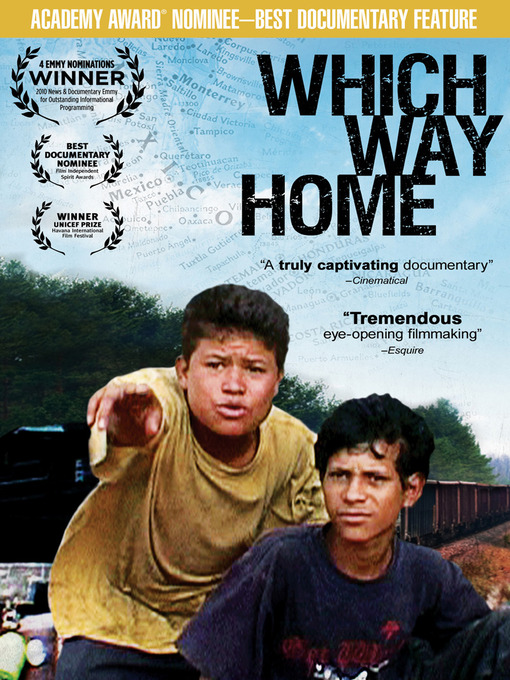
No comments:
Post a Comment